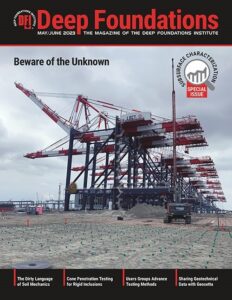Home / Communities / Subsurface Characterization / Initiatives
Subsurface Characterization
Committee Initiatives
Contents
GBR Initiative
Geotechnical baseline reports could be beneficial on a wide range of deep foundation projects, but these documents are widely misunderstood. The goal of this initiative is to raise the awareness and encourage the adoption of required geotechnical baseline reports to help promote timely, safer and more fiscally responsible projects by providing a clearer understanding of the soil conditions.
A Primer on Geotechnical Baseline Reports
Advanced Geotechnical Methods in Exploration (A-GaME)
DFI is excited to partner with FHWA’s A-GaME program. To learn more about A-GaME and access educational videos, news bulletins and more, visit the A-GaME website.
Or you can delve directly into the webinars, featuring proven exploration methods and practices for enhanced, effective site characterization that reduce project risks, improve quality and accelerate project delivery.
Geo-Industry Technology Users Groups
These joint industry groups were created in cooperation with FHWA, Geo-Institute, DOTs, DFI and TRB Committee AKG20 to address users’ needs.
Geophysics
This task force highlights how geophysical techniques can add value to investigation programs.
Special Subsurface Characterization issue of Deep Foundations magazine

Rigid inclusions are widely used in the U.S. as a ground improvement technique, particularly for industrial, low-rise and highway applications with poor subsurface conditions, where control of settlement is necessary. Rigid inclusions consist of grouted or concrete elements typically 12-24in(305-610mm) in diameter that may or may not be reinforced with a center bar. Typical soil conditions where rigid inclusions…
